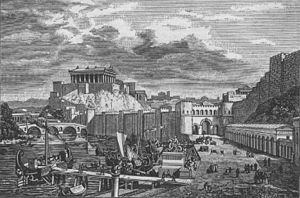Pons Sublicius
Coordinates: 41 ° 53 ′ 4 " N , 12 ° 28 ′ 36" E
| Pons Sublicius | ||
|---|---|---|
| Polack's idea of the Pons Sublicius | ||
| Convicted | Via Latina | |
| Crossing of | Tiber | |
| place | Rome ( Italy ) | |
| construction | Wooden bridge | |
| location | ||
|
|
||
The Pons Sublicius (Latin: pons = "bridge", sublicae = "wooden posts ") was the oldest bridge in Rome ( Italy ).
Location and time of origin
The pure wood construction, which probably corresponded to Caesar's Rhine bridge built much later , was probably located near the Forum Boarium below the Tiber Island at a shallow spot that had also been used as a ford. According to tradition, the bridge that connected Rome to the right bank of the Tiber and the Salt Road was built under the rule of King Ancus Marcius in the 7th century BC. Built in BC. The Via Latina ran over the Pons Sublicius . A drawing by Friedrich Polack from 1896 probably shows the correct position where the bridge was, but interprets the Pons Sublicius only as a jetty instead of as a crossing over the Tiber. The last remains of the Pons Sublicius were possibly only removed at the end of the 19th century and Pollack may have influenced his representation. Pier Luigi Tucci thinks that the fragments 138a – f and 574a – b of the Forma Urbis , a marble city map of Rome from the time of Septimius Severus , show a street that does not, as previously assumed, over the Pons Aemilius , but over the Pons Sublicius led. The bridge was destroyed and rebuilt several times, including in connection with the defense of Rome by Horatius Cocles .
The exploit of Cocles
Horatius Cocles is said to have called the Pons Sublicius 509 or 508 BC. Almost single-handedly defended against the hostile Etruscans under the leadership of Porsenna , who wanted to bring the overthrown tyrant Tarquinius Superbus back to power. Allegedly, the bridge was torn down during this battle to keep the Etruscans away from Rome. Livy reports (2, 10, 3):
- Qui positus in statione pontis, cum captum repentino impetu Ianiculum atque inde citatos decurrere hostes vidisset trepidamque turbam suorum arma ordinesque relinquere, reprehensans singulos, obsistens obtestansque deum et hominum fidem testabatur transit nequiquam deserto praesidium e in Palatio Capitolioque quam in Ianiculo fore. Itaque monere, ut pontem ferro, igni, quacumque vi possent, interrumpant; se impetum hostium, quantum corpore uno posset obsisti, excepturum.
- He was standing at the bridgehead and, when he saw that the hill Ianiculum had been taken in a sudden attack and from there the enemies were coming down at a stormy pace and that the frightened multitude of the Romans abandoned arms and lines of battle, he rebuked the individual men opposed to the masses> and swore them in all that is sacred to gods and men not to abandon their post and to flee. He assured that soon if they crossed the bridge and left it behind, there would be more enemies on the Palatine and the Capitol than on the Ianiculum. So he admonished them to demolish the bridge by iron, fire, and any effective method. He himself would intercept the attack of the enemy, as far as one could resist with a single body.
Cocles is said to have jumped into the Tiber after the bridge was torn down and the onslaught of the enemy was halted. Various versions circulate about the end of the story. The process is depicted on a coin from the time of Antoninus Pius .
The bridge was later rebuilt, but with a different construction: the superstructure could easily be removed in the event of an attack and then reattached later. In 69 BC A flood destroyed the bridge, which was then rebuilt. Also 23 BC The Pons Sublicius fell victim to a flood, but was apparently rebuilt later. The bridge was probably usable until at least the 5th century AD, remains may have existed until the end of the 19th century.
Gaius Gracchus and the Pons Sublicius
Another famous user of the bridge was Gaius Gracchus . He fled across the Pons Sublicius when his adversaries got the upper hand and was killed in a nearby grove. Before that, a battle between his pursuers and defenders had taken place on the Pons Sublicius.
Religion and rituals
The Pons Sublicius was under the protection of the pontifices . On the Ides of March , a procession went from the temples of Servius Tullius across the Pons Sublicius and threw statues of bound men into the Tiber. This warlike ritual - the enemies were symbolically destroyed - may have originated in Etruscan times. On May 15 ( Idus Maius ), straw puppets (so-called argei ) were thrown into the Tiber from the bridge to represent living prisoners.
Representations of the Pons Sublicius
The coin mentioned above comes from antiquity. Tommaso Laureti created the fresco in the Conservator's Palace in the 16th century, which depicts the battle for the bridge and the wooden structure in great detail.
The modern bridge
In 1919, the architect Marcello Piacentini built a new bridge a few meters downstream, which took the name Ponte Sublicio . It connects the Piazza di Porta Portese in Trastevere with the Piazza dell'Emporio in Testaccio .
literature
- Silvia Koci Montanari: The ancient bridges of Rome , Verlag Schnell & Steiner 2006, ISBN 3-7954-1814-3
- Karl Joachim Marquardt, Wilhelm Adolph Becker: Handbook of Roman Antiquities edited from the sources , p. 693 ff.
- Pier Luigi Tucci: Eight Fragments of the Marble Plan of Rome Shedding new Light on the Transtiberim , in: Papers of the British School at Rome , Volume 72, 2004


